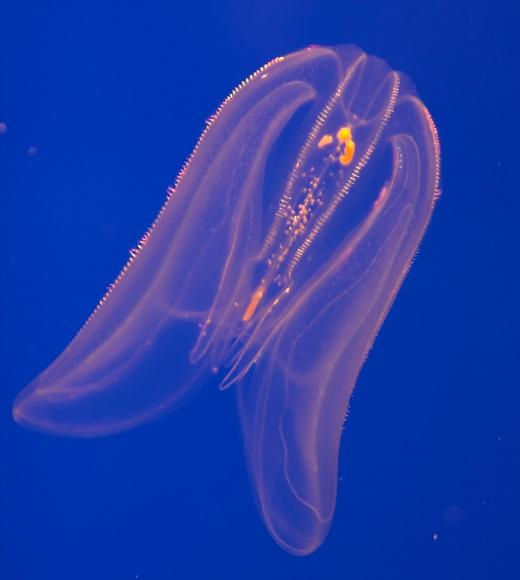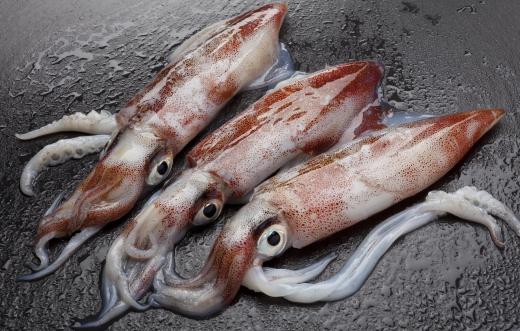Which Animals Live in the Aphotic Zone of the Ocean?
 Michael Anissimov
Michael Anissimov
Most of the ocean is completely dark. This is called the aphotic zone, and it begins at a depth of about 3,000 ft (0.9 km) and continues to the bottom, which usually maxes out at a depth of around 18,000 ft (5.5 km), except for ocean trenches, which can be as deep as 6.8 mi (11 km). In this zone, photosynthesis cannot occur, so the usual foundation of food webs, plants and cyanobacteria, are absent. Instead, animals have to subsist on carcasses that fall from above, other animals, and in some rare cases, bacteria that use chemical energy sources such as sulfides and methane. Some animals that live in the aphotic zone include the gulper eel, giant squid, smaller squids, anglerfish, vampire squid, and numerous jellyfish.
The aphotic zone is broken into two levels: the bathypelagic zone and the abyssopelagic zone. The bathypelagic zone extends from around 3,300 ft (1 km) below the surface to 13,000 ft (4 km) below. Below this is the abyssopelagic zone, also called the abyssal zone, where pressures are extremely high (400 atmospheres and up) and biodiversity drops sharply. Below this is the hadopelagic zone, which is used to refer to ocean trenches.

Some of the ugliest and most evil-looking fish in the world are found in these parts of the ocean, including the viper fish, fangtooth, dragonfish, lizardfish, and many others. These fish often have hinged jaws, black scales, piercing eyes, and extremely sharp teeth. Most people wouldn't want to run into them in a dark flooded alley. Some of them are named after their superficial similarity to reptiles.

Many of the animals in the aphotic zone are bioluminescent, meaning they can produce their own light in one way or another. This can be used both for navigation and luring small animals into their jaws. The angler fish is probably the most famous of examples, as it has a lure protruding in front of its mouth from a special appendage on its head.
Other fish look not so evil so much as blob-like. These bottom-feeders include the aptly-named blobfish and the coffin fish, which walk along the sea floor using leg-like fins. At the bottom one can also find sea cucumbers and giant isopods, foot-long relatives of woodlice. The deep sea also has numerous unusual and rare sharks, such as the Megamouth Shark, hailed as one of the most impressive marine animal discoveries of the last century.
AS FEATURED ON:
AS FEATURED ON:














Discussion Comments
yes they may be creepy, or to you ugly, but i think there as neat and different as we are. I think that there are so many things we can learn from these neat individuals. I know that because it's a place that doesn't get light that they have had to make changes but it's amazing what lives down there.
I'm having to do a project on this biome and i think it's awesome and want to learn as much as i can. i hope that you guys have learned so much as i have and want to continue on with this biome don't like science a whole lot until it comes to certain things and i love this!
I have to agree, the aphotic zone of the ocean is home to the weirdest looking animals on the planet.
Of course, you get some creepers in the neritic zones too -- what about hagfish? Or eels, for that matter.
I mean, I defy you to find a "pretty" eel.
Or what about a potato grouper? Regular groupers are kind of ugly, but a potato grouper is like a lumpy, super-sized, super-ugly grouper.
Maybe I'll just say on the beach this year...
Ooh, you get the creepiest looking animals in the aphotic zone.
For instance, the lantern fish -- talk about creepy! It's got giant black eyes, sharp, needle-like teeth that overlap and stick out of it's mouth, a protruding under-jaw, and, weirdest of all, a little protrusion coming out of their head like a fishing rod that has a small luminous tip.
They use that tip to lure fish towards them, and then gulp them down before they even realize what's going on.
You might recognize a lantern fish from finding Nemo, where Dory and Marlin go into the deep cavern looking for the dive mask, and are then drawn to the shiny floating light. Of course, it's a lantern fish.
Scary, scary looking things. I say, who needs to think about aliens and things from other planets -- earth plays host to so many creatures that we don't even know about, and look truly scarier than any alien that I can imagine.
I'll stick to the neritic zones of the ocean, thanks very much!
Are the benthic zones of the ocean related to the aphotic zones? I understood that the benthic zones included any part of the ocean floor, from the very shallow to the very deep.
So are the benthic zones part of the aphotic zone, or are these two unrelated?
this website was very useful.
Post your comments